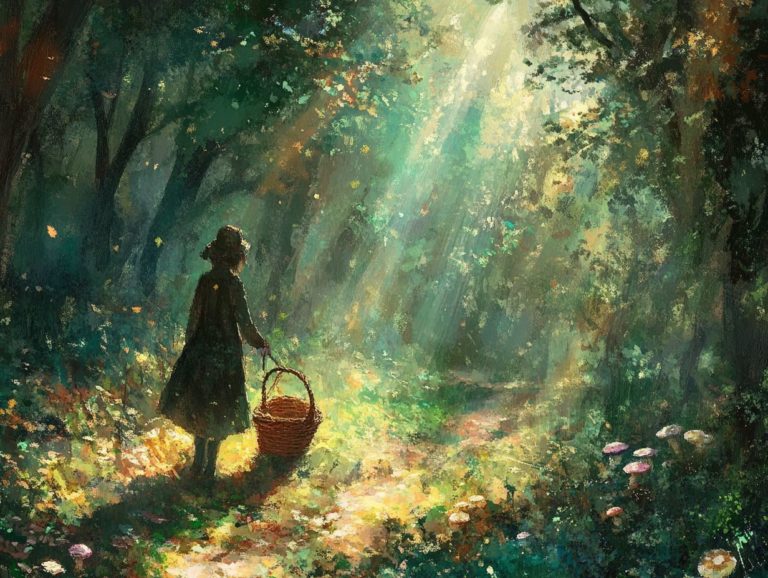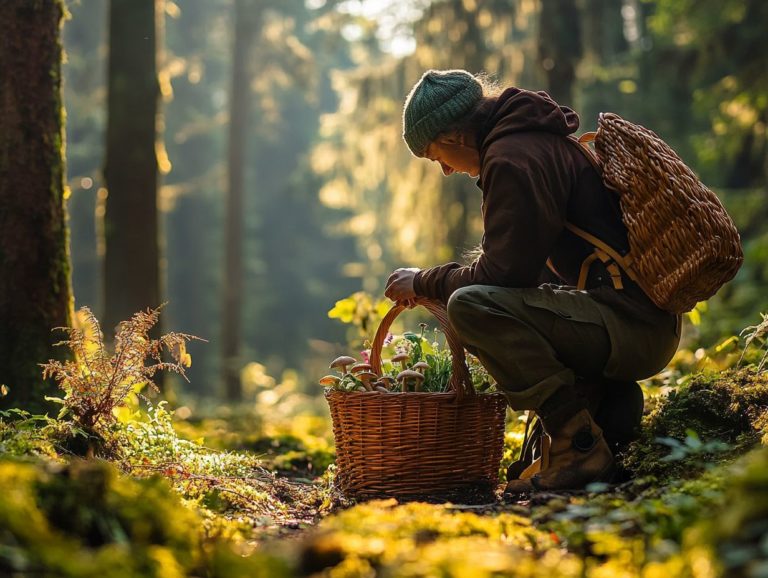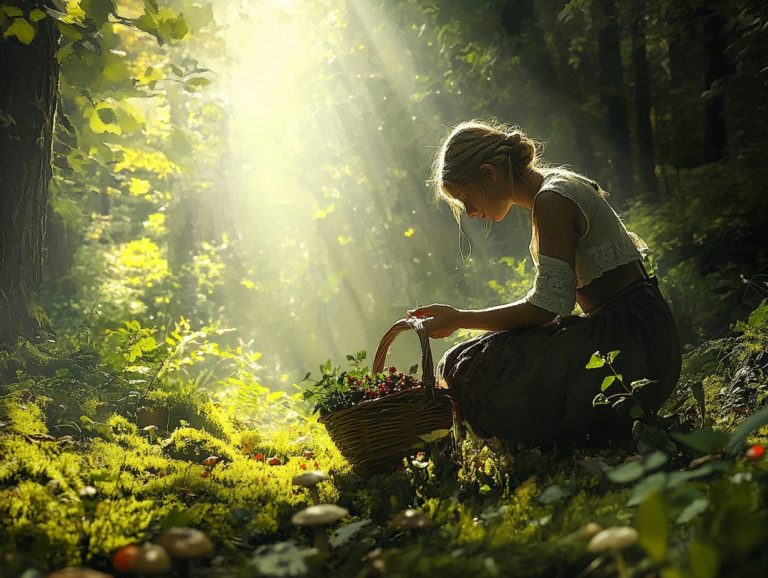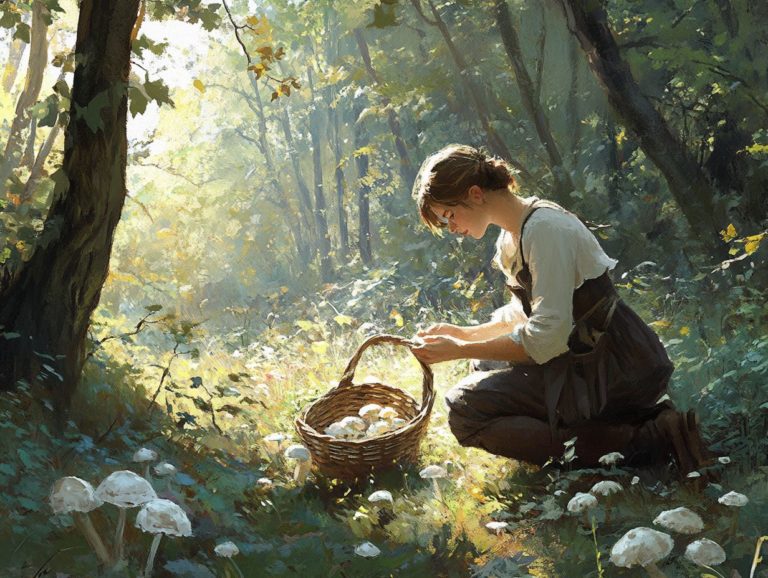What to Look for When Foraging
Foraging transcends mere trendiness; it s an enriching experience that forges a deeper connection with nature while offering a wealth of benefits.
This article delves into the nutritional and environmental advantages of foraging. It provides guidance on how to safely identify edible plants and fungi. You’ll also find essential tips on the tools you’ll need for your foraging adventures.
It highlights the best locations and seasons to forage, along with crucial precautions to ensure your journey is both safe and enjoyable.
Jump in and discover the exciting world of foraging!
Contents
Key Takeaways:
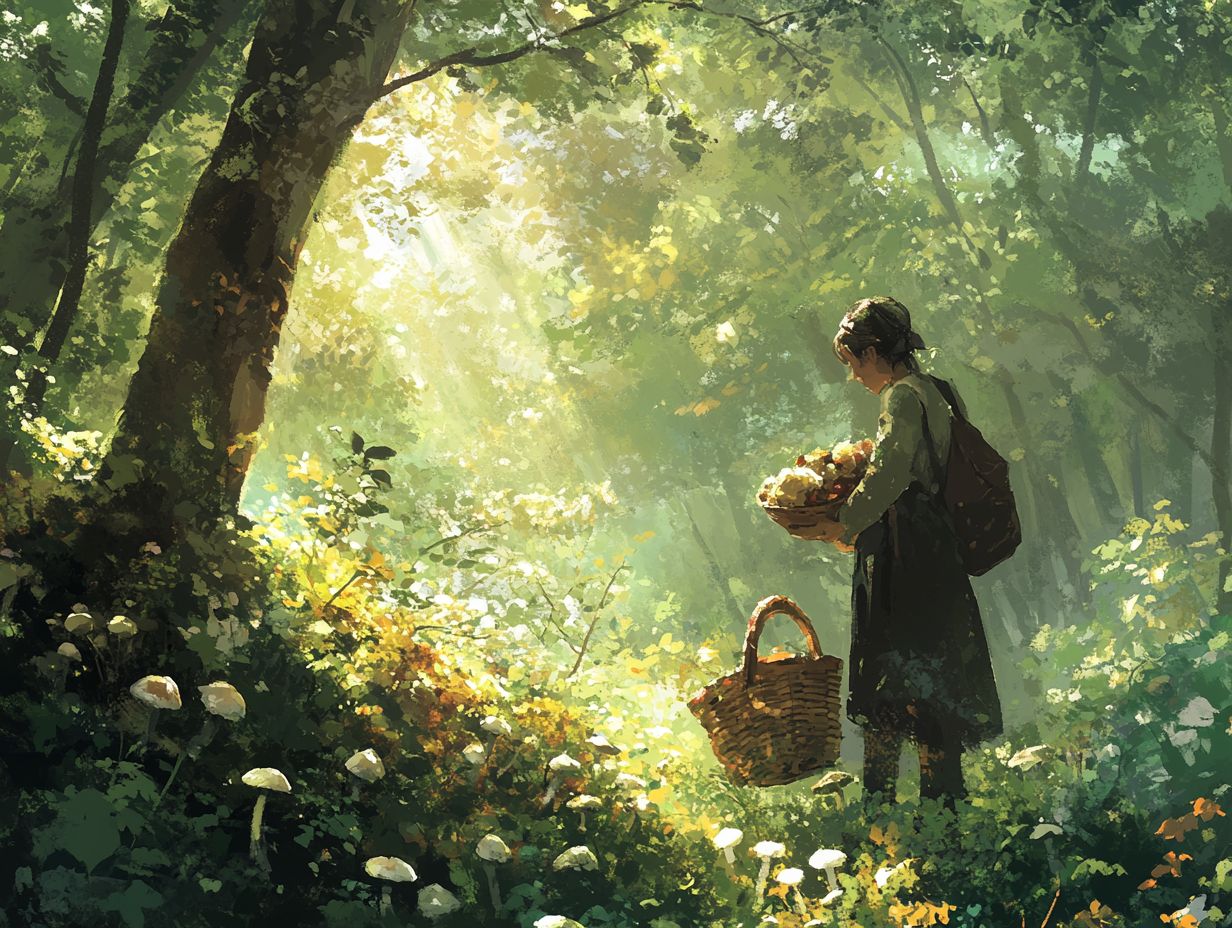
- Always properly identify edible plants and fungi before consuming when foraging to avoid potential hazards.
- Invest in the right tools and equipment for foraging to ensure a safe and successful experience.
- Forage in the right locations and during the appropriate seasons to maximize the nutritional and environmental benefits of foraging.
What is Foraging?
Foraging is your ticket to a flavorful adventure, where you search for and gather wild food think edible plants and seasonal produce right from local parks or forests. This food adventure allows you to connect with nature while uncovering a treasure trove of wild ingredients that often go unnoticed in your typical grocery store.
By learning to identify various species, from wild garlic to dandelion leaves, you can whip up healthy, nutrient-rich meals that are not only sustainable but also essentially free, capturing the true spirit of food for free.
Historically, foraging has been a cornerstone of human survival, reaching back to ancient civilizations that relied on the land for sustenance. In today’s world, this practice has transformed into a pursuit embraced by environmentally conscious individuals eager to reconnect with their food sources.
When you venture out to forage, you’ll commonly come across items like:
- Mushrooms
- Berries
- Various greens
Each of these delights offers unique flavors and health benefits. The philosophy of sustainable foraging underscores the importance of leaving plenty of each species in its natural habitat, ensuring that ecosystems remain balanced.
It’s essential to sharpen your identification skills to avoid toxic look-alikes. By honing these skills, you not only enhance your culinary repertoire but also nurture a deeper respect for the environment around you.
Benefits of Foraging
Foraging offers amazing benefits that can transform your life. It enhances your nutrition and deepens your connection with the environment. By embracing the art of gathering wild food, you unlock access to unique flavors and vibrant ingredients, all while cultivating a profound appreciation for sustainability and biodiversity.
This food adventure elevates your dietary choices with local, seasonal produce and encourages the responsible use of nature’s resources, making each foraged meal a celebration of both flavor and mindfulness.
Nutritional and Environmental Benefits
The nutritional benefits of foraging are abundant. When you explore the wild for plants like watercress and dandelion leaves, you’re often rewarded with a rich source of essential vitamins, including vitamin C, alongside crucial minerals that contribute to a balanced diet. But foraging isn’t just beneficial for your health; it also supports the environment by fostering sustainable practices that honor local ecosystems.
Many of those foraged greens are brimming with antioxidants and anti-inflammatory compounds that can enhance your overall well-being. Take nettles, for instance they’re packed with iron and calcium, making them a true powerhouse for promoting bone health.
By engaging in responsible harvesting from nature, you actively contribute to preserving the health of plant populations, ensuring these species flourish for generations to come. When you forage thoughtfully, you not only enjoy the nutritional benefits but also cultivate a deeper appreciation for nature’s riches, fostering a sense of stewardship towards the environment that sustains us all.
How to Safely Forage

To forage safely and responsibly, you must develop key skills to identify edible plants and their potentially harmful counterparts. This expertise is crucial, especially when foraging for mushrooms or wild garlic, as misidentifying them can pose serious health risks.
By following specific foraging tips, you can enrich your experience and enjoy wild food with newfound confidence.
Identifying Edible Plants and Fungi
Identifying edible plants and fungi is an essential skill in foraging. Many species have look-alikes that can be toxic. Through careful observation and thorough research, you can learn to recognize key features of wild ingredients.
Consider the distinct characteristics of chanterelle mushrooms or the unique aroma of wild garlic. These insights will enhance your culinary adventures.
Understanding visual cues or signs you can see is crucial. Examining leaf shapes, stem textures, and fruit colors can provide critical clues. Scents often serve as invaluable guides too. The earthy smell of morels or the sweet fragrance of elderflowers can be unmistakable indicators of their edibility.
As a beginner, you’ll find great value in using reputable field guides that include detailed illustrations. Enrolling in local herbal courses which teach you about wild plants can facilitate hands-on learning and help you connect more deeply with nature.
These resources help you identify safe options and cultivate a richer appreciation for the intricate relationships between nature and cuisine.
Tools and Equipment for Foraging
Using the right tools and equipment can elevate your foraging experience, making it easier to gather wild ingredients both efficiently and safely.
Starting with a reliable basket allows you to collect finds without harming the delicate ecosystem around you. A well-illustrated field guide is critical for accurately identifying various edible plants and mushrooms, helping you avoid unfortunate mishaps.
A sturdy knife is invaluable for tasks like cutting, digging, and cleaning your foraged treasures. For seasoned foragers, a pair of gloves protects your hands from thorns and irritants. A small brush is handy for gently removing dirt from your delicate finds.
These essential tools cater to both eager novices looking to learn and experienced foragers aiming to refine their practice.
Foraging Locations and Seasons
Finding the right spots and seasons for foraging is key to your success and adventure! Different wild ingredients flourish at various times throughout the year. Knowing this can truly elevate your foraging experience.
Local parks, woodlands, and meadows serve as diverse habitats where you can uncover seasonal delights, like luscious blackberries in late summer or sweet chestnuts in autumn. Each foraging trip transforms into a unique adventure, offering the thrill of discovery in the great outdoors.
Top Foraging Spots and Seasons
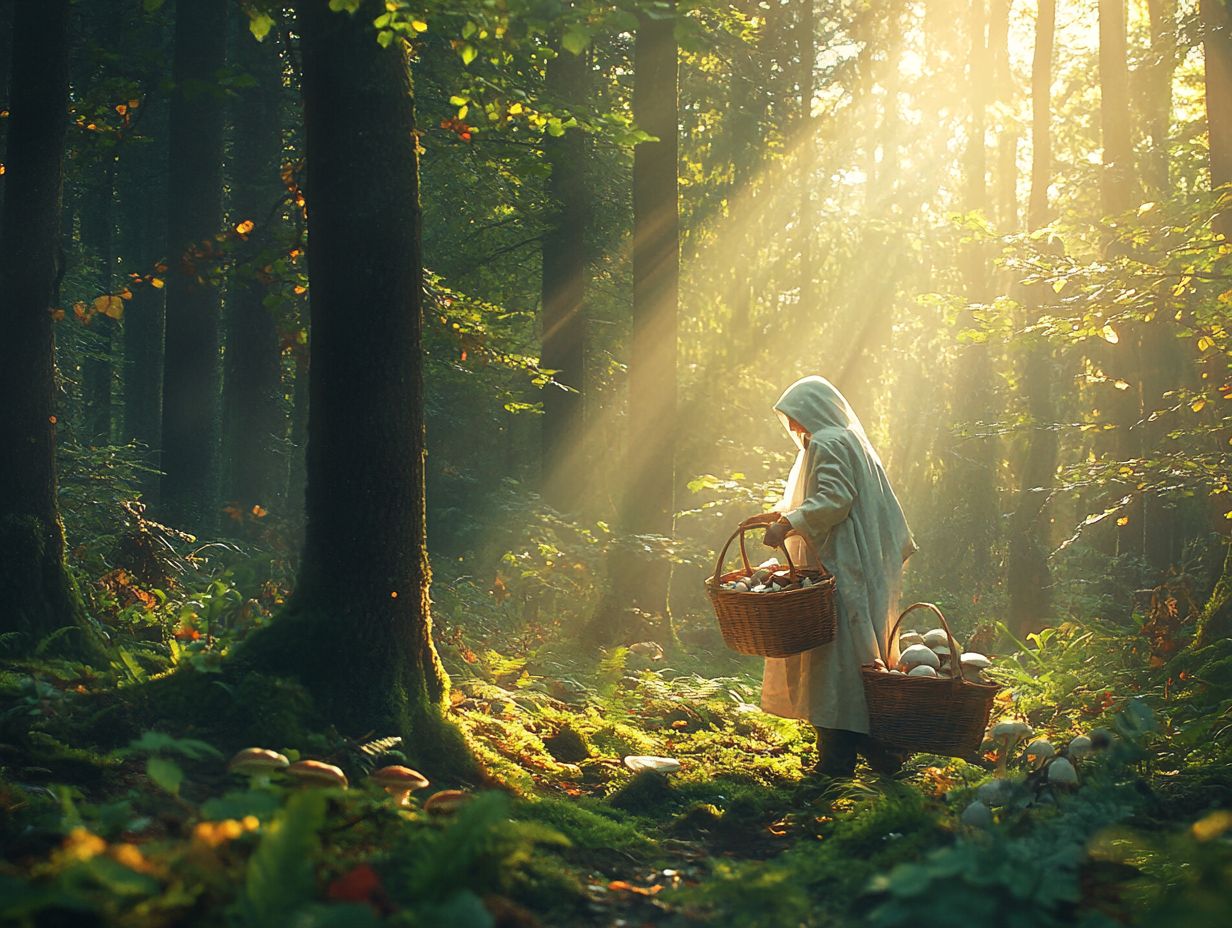
The best places for foraging are often local parks, forests, and charming, secluded meadows. These spots offer a delightful variety of seasonal produce waiting to be discovered.
Timing your foraging trips with the rhythm of the seasons allows you to enjoy wild ingredients like elderflowers in spring and succulent blackberries in late summer. This makes your cooking experience both rewarding and enjoyable.
Exploring the lush woodlands of the Pacific Northwest or the sprawling meadows of New England can lead to delightful surprises that enhance your foraging experience. By connecting with local foraging groups or engaging in online forums, you can uncover hidden gems filled with seasonal treats from ramps in early spring to fragrant wild mushrooms in the fall.
Connecting with experienced foragers offers invaluable insights into the safe identification of edible plants and foraging ethics. This ensures your journey is both responsible and enriching. Remember, deepening your knowledge of local flora and fauna sharpens your foraging skills and strengthens your bond with the natural world around you.
Precautions and Considerations
Engaging in foraging requires a mindful approach to ensure your safety and avoid potential hazards that can come with gathering wild food.
Learn to identify toxic plants to enjoy your foraging adventure safely. Steering clear of polluted areas will help you fully savor your culinary experience while minimizing the risks associated with foraging.
Potential Hazards and Safety Tips
Foraging can be fun, but it comes with risks. Here s what you need to know to stay safe.
Potential hazards in foraging can range from stumbling upon toxic plants like hemlock to foraging in areas tainted by pollutants. This is why safety tips are essential for anyone venturing into the wild.
By educating yourself about these dangers and staying vigilant, you can significantly reduce risks while enjoying the experience of gathering wild food. Familiarize yourself with the specific flora in your region to distinguish between safe and poisonous species.
Being aware of environmental factors is crucial. Pesticides in urban areas or heavy metals in nearby water sources could pose hidden threats.
When planning your foraging adventure, consider bringing along a knowledgeable companion or guide who can assist with plant identification. Engaging in community workshops and joining local foraging groups will provide you with invaluable hands-on experience and resources.
These educational opportunities not only sharpen your skills but also cultivate a sense of community among fellow enthusiasts, making foraging not just safer but also more enjoyable.
Frequently Asked Questions
-
What should I look for when foraging?
When foraging, you should look for edibles that are safe to consume, such as certain types of plants, mushrooms, fruits, nuts, and insects.
-
How do I identify edible plants when foraging?
There are a few key characteristics to look for when identifying edible plants, including recognizable leaves, branches or stems, and identifiable fruit or seeds.
-
What should I avoid when foraging?
You should avoid eating any plants or mushrooms that you are not 100% sure are safe to consume. Avoid foraging in areas that may be contaminated with chemicals or other pollutants. Familiarize yourself with plants like hemlock and chanterelle mushrooms to enhance your identification skills and ensure you forage safely.
What are some common poisonous plants to avoid when foraging?
Some poisonous plants to avoid when foraging include poison ivy, poison oak, and hemlock. Educate yourself on the plants in your area to ensure safety.
This knowledge helps you identify safe species, such as plantain and sweet chestnuts.
How can I ensure that the food I forage is safe to eat?
To ensure safety, properly identify the plants and mushrooms you collect. Talk to a local expert or use a reliable foraging guide for verification.
Resources like herbal courses or guides may provide insights from experts like Sam Thayer or Richard Maybe.
What are some tips for foraging safely and responsibly?
Forage responsibly by only taking what you need and being mindful of the environment. Always respect private property and seek permission before foraging on someone else’s land.
Explore local parks for exciting free food opportunities, such as wild seeds and mushrooms!


